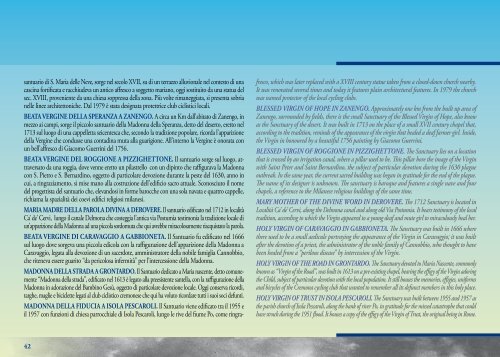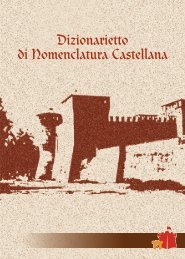luoghi e percorsi tra arte e fede nelle - Provincia di Cremona
luoghi e percorsi tra arte e fede nelle - Provincia di Cremona
luoghi e percorsi tra arte e fede nelle - Provincia di Cremona
You also want an ePaper? Increase the reach of your titles
YUMPU automatically turns print PDFs into web optimized ePapers that Google loves.
santuario <strong>di</strong> S. Maria delle Neve, sorge nel secolo XVII, su <strong>di</strong> un terrazzo alluvionale nel contesto <strong>di</strong> una<br />
cascina fortificata e racchiudeva un antico affresco a soggetto mariano, oggi sostituito da una statua del<br />
sec. XVIII, proveniente da una chiesa soppressa della zona. Più volte rimaneggiata, si presenta sobria<br />
<strong>nelle</strong> linee architettoniche. Dal 1979 è stata designata protettrice club ciclistici locali.<br />
Beata verGine della sPeranza a zanenGo. A circa un Km dall’abitato <strong>di</strong> Zanengo, in<br />
mezzo ai campi, sorge il piccolo santuario della Madonna della Speranza, detto del deserto, eretto nel<br />
1713 sul luogo <strong>di</strong> una cappelletta seicentesca che, secondo la <strong>tra</strong><strong>di</strong>zione popolare, ricorda l’apparizione<br />
della Vergine che condusse una conta<strong>di</strong>na muta alla guarigione. All’interno la Vergine è onorata con<br />
un bell’affresco <strong>di</strong> Giacomo Guerrini del 1756.<br />
Beata verGine del roGGione a PizziGhettone. Il santuario sorge sul luogo, at<strong>tra</strong>versato<br />
da una roggia, dove venne eretto un pilastrello con un <strong>di</strong>pinto che raffigurava la Madonna<br />
con S. Pietro e S. Bernar<strong>di</strong>no, oggetto <strong>di</strong> particolare devozione durante la peste del 1630, anno in<br />
cui, a ringraziamento, si mise mano alla costruzione dell’e<strong>di</strong>ficio sacro attuale. Sconosciuto il nome<br />
del progettista del santuario che, elevandosi in forme barocche con una sola navata e quattro cappelle,<br />
richiama la spazialità dei coevi e<strong>di</strong>fici religiosi milanesi.<br />
Maria Madre della Parola <strong>di</strong>vina a derovere. Il santuario e<strong>di</strong>ficato nel 1712 in località<br />
Ca’ de’ Cervi, lungo il canale Delmona che costeggia l’antica via Postumia testimonia la <strong>tra</strong><strong>di</strong>zione locale <strong>di</strong><br />
un’apparizione della Madonna ad una piccola sordomuta che qui avrebbe miracolosamente riacquistato la parola.<br />
Beata verGine <strong>di</strong> caravaGGio a GaBBioneta. Il Santuario fu e<strong>di</strong>ficato nel 1666<br />
sul luogo dove sorgeva una piccola e<strong>di</strong>cola con la raffigurazione dell’apparizione della Madonna a<br />
Caravaggio, legata alla devozione <strong>di</strong> un sacerdote, amminis<strong>tra</strong>tore della nobile famiglia Cannobbio,<br />
che riteneva essere guarito “da pericolosa infermità” per l’intercessione della Madonna.<br />
Madonna della s<strong>tra</strong>da a Grontardo. Il Santuario de<strong>di</strong>cato a Maria nascente, detto comunemente<br />
“Madonna della s<strong>tra</strong>da”, e<strong>di</strong>ficato nel 1613 è legato alla preesistente santella, con la raffigurazione della<br />
Madonna in adorazione del Bambino Gesù, oggetto <strong>di</strong> particolare devozione locale. Oggi conserva ricor<strong>di</strong>,<br />
targhe, maglie e biciclette legati al club ciclistico cremonese che qui ha voluto ricordare tutti i suoi soci defunti.<br />
Madonna della Fiducia a isola Pescaroli. Il Santuario viene e<strong>di</strong>ficato <strong>tra</strong> il 1955 e<br />
il 1957 con funzioni <strong>di</strong> chiesa parrocchiale <strong>di</strong> Isola Pescaroli, lungo le rive del fiume Po, come ringra-<br />
fresco, which was later replaced with a XVIII century statue taken from a closed-down church nearby.<br />
It was renovated several times and today it features plain architectural features. In 1979 the church<br />
was named protector of the local cycling clubs.<br />
BLesseD virGin of hoPe in zanenGo. Approximately one km from the built up area of<br />
Zanengo, surrounded by fields, there is the small Sanctuary of the Blessed Virgin of Hope, also know<br />
as the Sanctuary of the desert. It was built in 1713 on the place of a small XVII century chapel that,<br />
accor<strong>di</strong>ng to the <strong>tra</strong><strong>di</strong>tion, reminds of the appearance of the virgin that healed a deaf farmer girl. Inside,<br />
the Virgin in honoured by a beautiful 1756 painting by Giacomo Guerrini.<br />
BLesseD virGin of roGGione in PizziGhettone. The Sanctuary lies on a location<br />
that is crossed by an irrigation canal, where a pillar used to be. This pillar bore the image of the Virgin<br />
with Saint Peter and Saint Bernar<strong>di</strong>no, the subject of particular devotion during the 1630 plague<br />
outbreak. In the same year, the current sacred buil<strong>di</strong>ng was began in gratitude for the end of the plague.<br />
The name of its designer is unknown. The sanctuary is baroque and features a single nave and four<br />
chapels, a reference to the Milanese religious buil<strong>di</strong>ngs of the same time.<br />
Mary Mother of the Divine worD in Derovere. The 1712 Sanctuary is located in<br />
Località Ca’ de’ Cervi, along the Delmona canal and along old Via Postumia. It bears testimony of the local<br />
<strong>tra</strong><strong>di</strong>tion, accor<strong>di</strong>ng to which the Virgin appeared to a young deaf and mute girl to miraculously heal her.<br />
hoLy virGin of CaravaGGio in GaBBioneta. The Sanctuary was built in 1666 where<br />
there used to be a small ae<strong>di</strong>cule por<strong>tra</strong>ying the appearance of the Virgin in Caravaggio; it was built<br />
after the devotion of a priest, the adminis<strong>tra</strong>tor of the noble family of Cannobbio, who thought to have<br />
been healed from a “perilous <strong>di</strong>sease” by intercession of the Virgin.<br />
hoLy virGin of the roaD in GrontarDo. The Sanctuary devoted to Maria Nascente, commonly<br />
known as “Virgin of the Road”, was built in 1613 on a pre-existing chapel, bearing the effigy of the Virgin adoring<br />
the Child, subject of particular devotion with the local population. It still houses the memories, effigies, uniforms<br />
and bicycles of the <strong>Cremona</strong> cycling club that wanted to remember all its defunct members in this holy place.<br />
hoLy virGin of trust in isoLa PesCaroLi. The Sanctuary was built between 1955 and 1957 as<br />
the parish church of Isola Pescaroli, along the bank of river Po, in gratitude for the missed catastrophe that could<br />
have struck during the 1951 flood. It houses a copy of the effigy of the Virgin of Trust, the original being in Rome.<br />
I SANTUARI MARIANI<br />
Marian Shrines<br />
ziamento per lo scampato pericolo della <strong>di</strong>sastrosa alluvione<br />
hoLy virGin of seniGoLa in PesCaroLo.<br />
del 1951 e custo<strong>di</strong>sce una riproduzione della effige della<br />
Located in the open countryside, the Church of the Holy<br />
Madonna della Fiducia, copia <strong>di</strong> quella venerata a Roma.<br />
Virgin of Senigola was built in 1607 but the chronicles<br />
Madonna della seniGola a Pescarolo. Posta<br />
report its existence since the early Middle Ages. Today it<br />
in aperta campagna, la chiesa della Madonna della Senigola,<br />
is a simple yet elegant buil<strong>di</strong>ng that testifies to an ancient<br />
Marian cult, connected with the mystery of the Annun-<br />
eretta nel 1607 ma documentata fin dall’alto me<strong>di</strong>oevo,<br />
ciation. Inside, the church houses a polychrome marble<br />
si presenta oggi come un e<strong>di</strong>ficio semplice ma elegante<br />
altar dating back to the second half of the XVIII century.<br />
attestante un antico culto mariano, particolarmente legato<br />
al mistero dell’annunciazione. Al suo interno conserva un<br />
BLesseD virGin of the fountain in Ca-<br />
altare a marmi policromi della seconda metà del XVIII secolo.<br />
saLMaGGiore. The Sanctuary was built in 1471 in<br />
the place where an image of the Virgin used to be painted<br />
Beata verGine della Fontana a casalon<br />
a wall, at whose feet there used to be a water spring,<br />
MaGGiore. ll Santuario sorge nel 1471 sul luogo dove<br />
thought to be miraculous. This ancient place seems to be<br />
esisteva un’immagine mariana <strong>di</strong>pinta su <strong>di</strong> un muro, alla<br />
identified in the crypt of the current sanctuary, which is<br />
cui base sgorgava una sorgente d’acqua, ritenuta miracolosa.<br />
also the destination of many pilgrims and devout among<br />
Questo antico luogo sembra possa essere in<strong>di</strong>viduato nella<br />
the citizens of Casalmaggiore. The frescoes made in the<br />
cripta dell’attuale santuario che è meta <strong>di</strong> pellegrinaggi e <strong>di</strong><br />
same period as the church are of particular interest; in<br />
devozioni della gente casalasca. Interessante è il corredo <strong>di</strong><br />
the second chapel on the left there is the burial monu-<br />
affreschi coevi alla costruzione della chiesa; nella seconda<br />
ment of the painter Francesco Mazzola, also known as<br />
cappella <strong>di</strong> sinis<strong>tra</strong> si trova il monumento funerario del casalmaggiore, Beata vergine della Fontana<br />
Parmigianino, who <strong>di</strong>ed in 1540 in a farmhouse nearby.<br />
pittore Francesco Mazzola, noto come il Parmigianino,<br />
che morì nel 1540 in una cascina situata nei <strong>di</strong>ntorni.<br />
other sanCtuaries are aLso Part of<br />
the CreMona DioCese:. santa Maria del fonte (saint Mary of the spring) in Carav-<br />
della <strong>di</strong>ocesi <strong>di</strong> creMona Fanno P<strong>arte</strong> anche altri santuari: santa aggio (BG), the main Marian sanctuary in Lombardy and the rest of Italy. It is in memory of the<br />
Maria del Fonte a caravaggio (BG), il principale santuario mariano della Lombar<strong>di</strong>a e <strong>di</strong> tutto il appearance of the Virgin to a young unhappy and vexed bride, Giannetta Vacchi, that took place<br />
Nord Italia. Ricorda l’apparizione della Madonna a una giovane sposa infelice e vessata, Giannetta in a meadow at Mazzolengo, just outside of Caravaggio, on May 26, 1432. The current Sanctu-<br />
Vacchi, avvenuta nel prato <strong>di</strong> Mazzolengo, fuori dal borgo <strong>di</strong> Caravaggio il 26 maggio 1432. Il santuario ary, designed by Pellegrino Tibal<strong>di</strong>, was built starting in 1571. The Virgin of Caravaggio is the<br />
attuale, progettato da Pellegrino Tibal<strong>di</strong> è stato costruito a partire dal 1571. La Madonna <strong>di</strong> Caravaggio Saint Patron of the <strong>Cremona</strong> <strong>di</strong>ocese; Blessed virgin of the rosary in Antegnate (BG), Beata<br />
è patrona della Diocesi <strong>di</strong> <strong>Cremona</strong>; Beata vergine del rosario ad Antegnate (BG), Beata vergine vergine dei Campi (Blessed virgin of the Fields) in Brignano Gera d’Adda (BG); Madonna del<br />
dei campi a Brignano Gera d’Adda (BG); Madonna del Miracolo a Cassano d’Adda (MI), Beata Miracolo (Virgin of the Miracle) in Cassano d’Adda (MI), Beata vergine della rotonda (Blessed<br />
vergine della rotonda a Pumenengo (BG), Madonna <strong>di</strong> loreto a Torre Pallavicina (BG).<br />
Virgin of the Rotunda) in Pumenengo (BG), and the virgin of Loreto in Torre Pallavicina (BG).<br />
42 43



